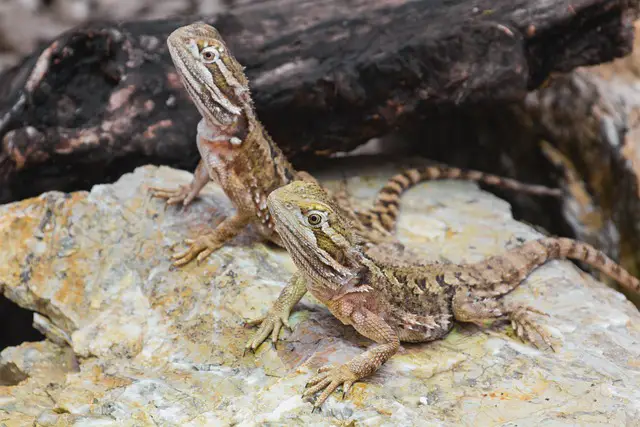Bearded dragons are popular pets due to their docile nature and unique appearance. However, many owners are unsure whether they can house a baby bearded dragon with an older one. While it may seem like a good idea to keep them together, several factors should be considered before introducing them.
Firstly, it is essential to note that bearded dragons are solitary animals and do not require a companion for socialization.
In fact, introducing a baby bearded dragon to an older one can lead to territorial disputes and aggression.
Additionally, baby bearded dragons have different care requirements than older ones, such as different feeding schedules and temperature needs.
Therefore, it is recommended to house them separately to ensure their individual needs are met.
While it may seem like a good idea to put a baby bearded dragon with an older one, it is not recommended due to the risk of aggression and differing care requirements.
Owners should prioritize the individual needs of each bearded dragon and provide them with separate living spaces to ensure their health and well-being.
Housing Baby and Older Bearded Dragons
Separate Enclosures for Baby-Bearded Dragons
It is recommended to house baby bearded dragons separately from older ones. This is because baby bearded dragons are more vulnerable and can easily be injured or stressed by larger, more dominant dragons. In addition, a separate enclosure allows you to monitor the baby’s feeding and growth more closely.
Introducing Baby-Bearded Dragons to Older Ones
If you do decide to house baby and older bearded dragons together, it is essential to introduce them slowly and carefully.
Place the baby in the enclosure first and allow it to acclimate for a few days before introducing the older dragon. Ensure the enclosure is large enough for both dragons to have space and hiding spots.
Signs of Aggression or Stress
Watch for signs of aggression or stress in both dragons. These can include biting, hissing, puffing up, or hiding. If you notice these behaviors, separate the dragons immediately to prevent injury.
Supervision and Interaction
Always supervise interactions between baby and older bearded dragons. While some dragons may get along well, others may not. Therefore, never leave them unsupervised, especially during feeding time.
Feeding Baby and Older Bearded Dragons
It is essential to feed a baby and older bearded dragons separately. Baby dragons require more frequent feedings and a different diet than adults. Ensure each dragon has its food dish and that the baby gets enough food without being bullied by the older dragon.
In conclusion, while it is possible to house baby and older bearded dragons together, it is recommended to keep them in separate enclosures to prevent injury and stress.
If you decide to house them together, introduce them slowly and carefully and always supervise their interactions. Then, feed them separately to ensure they are both getting the proper nutrition.
Care and Maintenance
Temperature and Lighting Requirements
When keeping multiple bearded dragons together, it is essential to ensure they can bask under the heat and UVB lamps. The temperature should be maintained between 95-105°F in the basking spot and around 80-85°F on the cooler side of the enclosure.
The UVB lamp should be on for 12-14 hours a day, and the basking lamp should be on for 10-12 hours. Monitoring the temperature and lighting levels regularly is essential to ensure they are within the recommended ranges.
Cleaning and Sanitation
When housing multiple bearded dragons together, it is vital to maintain a clean and sanitary environment. Therefore, the enclosure should be spot-cleaned daily and thoroughly cleaned and disinfected once a month.
The substrate should be changed regularly, and any uneaten food should be removed promptly to prevent bacterial growth. In addition, it is recommended to use a reptile-safe disinfectant to clean the enclosure and accessories.
Health and Wellness
Bearded dragons are prone to specific health issues like metabolic bone disease and respiratory infections. Therefore, when housing multiple bearded dragons together, it is essential to monitor their health closely.
Signs of illness include lack of appetite, lethargy, weight loss, and abnormal behavior. If any of these signs are noticed, taking the bearded dragon to a reptile veterinarian as soon as possible is essential.
In conclusion, when keeping multiple bearded dragons together, it is essential to provide them with the proper temperature and lighting requirements, maintain a clean and sanitary environment, and monitor their health closely.
Conclusion
In conclusion, putting a baby bearded dragon with an older one is not recommended. While introducing them to each other may seem like a good idea, there are several reasons why it is not a good idea.
Firstly, baby bearded dragons are very fragile and can be easily injured by older ones. They are also more susceptible to diseases and infections, which can be transmitted to older dragons.
Secondly, older bearded dragons are territorial and may become aggressive toward the younger ones. This can lead to fighting and injuries, which can be fatal for the baby dragons.
Finally, it is essential to note that bearded dragons are solitary animals and do not require the company of other dragons. They are happy living alone and do not need a companion to thrive.
In summary, keeping baby bearded dragons separate from older ones is best to ensure their health and safety. Providing them with a suitable environment and proper care is essential to ensure their well-being.




